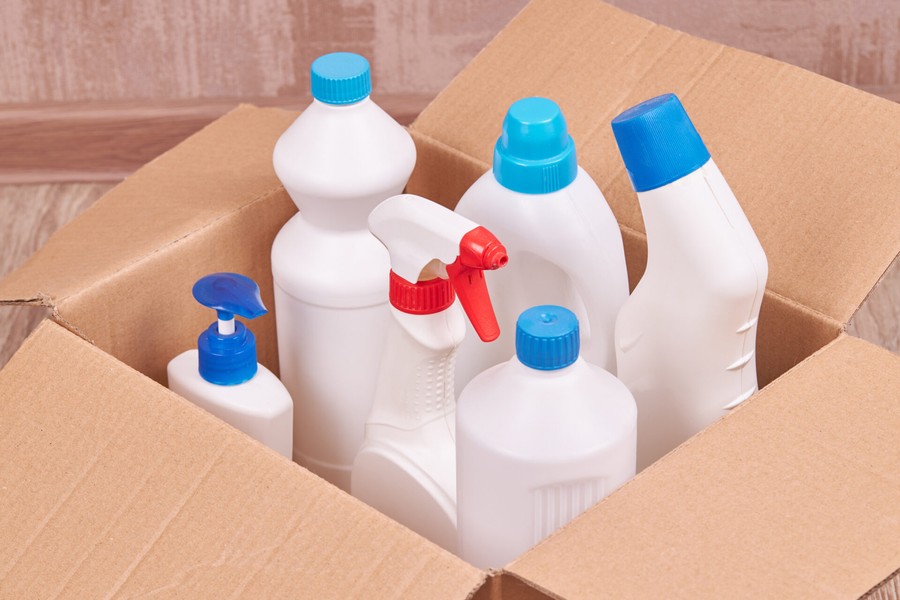Packing can definitely be a hassle, but safely transporting liquids? Now, that’s another story. Picture unpacking your ‘bathroom box,’ only to discover your shampoo has leaked all over your hairbrushes.
Packing liquids is no joke, whether it’s your hair products, cleaning supplies, or that bottle of great wine you have been saving.
The thought of a moving box tearing, leaking, or, even worse, ruining the whole container can indeed be nerve-wracking.
However, fear not! With a bit of planning and clever tactics, you can ensure your drinks are transported safely and securely to your new location. Here’s how you approach liquid packaging without causing heartache or spillage.
1. Start with the Right Boxes
The first thing to consider when packing liquids is choosing the right box. A sturdy, waterproof one will go a long way in preventing any spills or leaks from causing damage.
Books and clothes suit conventional boxes. Yet, when it comes to liquids, greater protection is needed. Given the weight of liquids, the last thing you want is a flimsy box collapsing on moving day.
Another critical factor is size. It can be tempting to pack as much as possible into one large box. However, keep in mind that the heavier the box, the more likely its contents will shift or spill during the move.
We’ll let you in on a little secret. Those dish-pack boxes with partitions are perfect for bottle packing.
2. Seal Everything Tightly
To avoid a surprise sticky mess, every bottle, jar, or container should be properly sealed extremely well.
Consider placing some cling film beneath the cap before you twist it back into place to give you that extra reassurance. In case the seal is not quite as tight as it should be, this additional barrier can help stop leaks.
Let’s take it a step further. For items like cooking oils or shampoo bottles, use packing tape to firmly seal the tops. This simple trick has saved countless suitcases and moving boxes from chaos.
3. Use Ziplock Bags for Extra Protection
Accidents still happen even after lids are secured and plastic wrap is added. Ziplock bags are, therefore, quite useful.
To catch any unplanned spills, pop every liquid item into its own ziplock bag. Double-bag it for more defence.
Though it can seem a bit extreme, it’s best to be safe than sorry when handling anything like bleach or oil paint.
Keeping cleaning chemicals or anything that can be hazardous in ziplock bags also helps protect other goods in the same box. Should something leak, the bag will carry the mess and stop it from damaging your possessions.
4. Keep Liquids Upright
This one seems obvious, but keep your liquids upright. Laying bottles flat to maximise box space can be appealing, but this is a surefire way to disaster.
Keeping bottles straight guarantees that gravity will assist in keeping your drinks in place even if the cap is not flawless.
To avoid crushing delicate items, pack liquids in moving boxes with heavier goods, like cleaning bottles, at the bottom and lighter items on top.
Consider adding some extra padding between the bottles for proper arrangement, or you can even use separators.
Any gaps can be filled with towels, used clothing, or packing paper to stop the liquids from shifting about within the box.
5. Label the Boxes Clearly
Clearly marked boxes can save you the stress of trying to remember where you put those expensive essential oils.
A large “liquids” sticker or a handwritten note can remind both you and the movers to handle that box with care.
You also want to identify which direction is up to prevent liquids from being carried sideways. Leaks can be prevented by only doing a basic “This Side Up” on all sides of the box.
6. Avoid Overpacking the Box
It’s understandable to want to maximise each box’s potential by filling it to the brim. However, when it comes to liquids, overfilling is risky.
The odds of breakages and spills increase when a box is overloaded with bottles. Particularly, liquids call for some breathing room. Confirm that enough room exists to cushion and guard every object.
This will provide the box with added solidity while also shielding the bottles from colliding with one another. The less jostling the liquids experience, the lower the chance of spills.
7. Consider Using Plastic Bins
If the possibility of leaks worries you, think about completely throwing away cardboard and utilising plastic containers for your liquids.
When it comes to anything prone to spilling, plastic bins are sturdier, waterproof, and reusable. They are an excellent substitute for moving boxes.
If a bottle of juice, wine, or detergent breaks, the liquid will be trapped in the bin. This prevents it from soaking through a cardboard box and onto your floor.
They also are easy to clean. Unlike cardboard, which you will need to discard, a quick wipe-down will have the bin good as new should something leak.
8. Don’t Pack Unnecessary Liquids
Just packing less of them will be one of the best methods to prevent disaster while carrying liquids.
Re-evaluate your belongings and make decisions about what you truly need to pack. Is it worth packing that half-used shampoo bottle? Leaving certain liquids behind or using them at the last minute before the relocation could be simpler.
Hazardous liquids are better off being disposed of carefully before the move than packed. When it comes to transferring them, less is more.
9. Transport Valuable Liquids Separately
A few liquids are more valuable than others. Never give a removal truck the power to determine the future of your cherished items, like a classic wine bottle or a high-end perfume.
Consider driving it separately in your own car. This helps you guarantee that it is handled with extra care.
Safely pack it in your car, cushioned and facing up. Monitor it all through the trip. Knowing that your things are within your control can help you relax.
10. Check for Temperature Sensitivity
Some liquids do not handle high temperatures well, meaning you should take climate into account during your relocation. Too much heat or cold can destroy items, including wine, perfume, or some cosmetics.
Take care if your move falls during an extra hot or cold season. To prevent damage, think about separate transportation of temperature-sensitive objects or insulated packing materials.
Keeping an eye on the weather forecast for your moving day can give you an idea of the hurdles ahead.
Conclusion
Packing liquids doesn’t have to be a messy ordeal. Smart strategising, coupled with innovative methods, ensures the protection and preservation of your beloved bottles.
Start with sturdy boxes, seal everything tightly, and label your boxes boldly to avoid last-minute chaos.
Do you want to simplify the process even more? Consider hiring a moving boxes delivery service to lighten your load.
With the right supplies, you can focus on the exciting adventure ahead, leaving spills and leaks behind.




